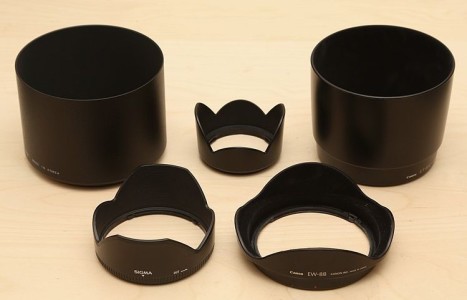![]()
Lens hood
The lens hood is a device to literally shade the end of the photographic lens from bright light. It seems counter-intuitive to want to exclude light from a lens. However, there are important reasons for having a lens hood…
- Prevent/reduce lens flare: Lens flare causes bright spots on the image which are not there in the scene. The problem is caused by light hitting the lens at a sharp angle from the side. Lenses work best with parallel rays of light entering the lens from the front. The lens hood cuts off the intrusion of light entering from a sharp side angle and therefore reduces the angle at which light can enter the lens.
- Prevent/reduce lens ghosting: bright hazy lens artefacts or secondary images caused by light bouncing around inside the lens or individual elements.
- Prevent/reduce lens Haze: Haze is caused by light scattering into the lens from the surface of the front lens element. An improved surface finish and/or various coatings can reduce the haze. However, the lens hood will reduce the effect even more.
- Lens protection: Lens hoods protect the lens from damage as they provide a physical barrier to striking the front lens element against large objects. Obviously objects can still strike the lens with a lens hood but the danger is reduced.
Types of lens hoods
Lens hoods vary a great deal in design. Some are usable in more general cases, and some designed specifically to optimise the hood shape to the needs of an individual lens.

• Five Types Of Lens Hood •
Attribution: Photo of five lens hoods for a mix of lenses; March 2013; Author: Geni; Permission: GFDL CC-BY-SA
The shape of the lens hood would ideally be conical and as deep as possible. However, the shape of the lens and the angle of view of the lens dictate the shape.
Design elements of lens hoods
- Corner cut-away: To prevent the corners of the sensor seeing parts of the hood (creating a vignette) some lens hoods have the parts around the corners cut away. This creates a wavy top edge leading to them sometimes being referred to as petal or flower hoods. However, this allows the worst of the side light to be reduced without increasing vignetting effects.
- Depth of hood: measured from where the hood affixes to the lens to the top outside edge of the hood. Depth is determined by the field of view and the amount of light that a hood cuts out. The effect of depth is always a play-off between the benefit of cutting out incident side-light and reducing the overall light entering the lens. Individual characteristics of the lens shape, lens coating on the front lens element and the optical properties of the glass and optical characteristics (shape) of the lens will all affect the design depth.
- Hood flare: The degree to which the edge furthest from the lens has a circumference that is greater than the base of the hood where it screws onto the lens. The degree of flare is determined by the field of view of the lens. This the flare on a wide angle lens will have a much greater flare than a long lens where the field of view of the lens is restricted.
- Type of photographic lens: Zoom lenses where the zoom part of the lens extends may be unsuitable for petal type hoods. If the extending part rotates during change of focal length the rotation prevents the use of corner-cut-outs because the corners would not necessarily be in the right place to match the sensor shape.
Construction materials
Most lens hoods for DSLRs are made of robust and rigid, light plastic. This helps protect the lens but is not very adaptable. Some lens hoods, particularly on lenses with a very wide range of fields of view (at different focal lengths), are collapsible. This allows the hood to have its depth adjusted for wide angle or zoomed shots.
Storage
Lens hoods are cumbersome to store as they are mostly empty space. Most manufacturers design the lens and the lens hood with reversible fittings. This allows the hood to be affixed to the lens facing forward during use, or for it to be affixed in a reversed position for storage at other times. In the reversed position it is screwed to the lens but the lens is partially inside the hood.
Photographic Glossary – Definitions, articles and resources…
Definition: Photographic lens
Definition: Lens flare; Flare (on a lens);
Definition: Lens element; Element
Definition: Vignette; Vignetting
Definition: Lens element; Element
Definition: DSLR; Digital Single Lens Reflex Camera
Comments, additions, amendments or ideas on this article? Contact Us



